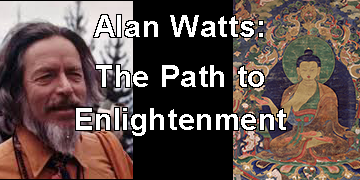



00:00
Now then ... We have to get on to Buddhism.
And in order to introduce Buddhism, it’s necessary to remember the whole background of the ... world view of India. In other words, what we’re going to study first of all, to understand Buddhism, is Indian cosmology, just as you would have to study the cosmology of the Ptolemaic view of the world in order to understand Dante. And in order to understand lots of things about medieval Christianity.
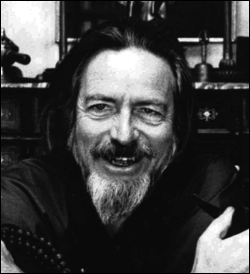
So we will begin with the cosmology of the Hindus; their view of the universe has come right into Japanese life through Buddhism. But it ante-dates Buddhism. Buddhism simply adopted it as a matter of course, just as now, if you invented a new religion, you would probably adopt the cosmology of modern astronomy.
01:00
Well now, how does the Hindu see the world?
You know there are really three great views of the world that human beings have had. And they go:
One is the western view of the world, which looks upon the world as a construct, an artefact, by analogy with ceramics and carpentry.
Then there is the Hindu view of the world, which is dramatic—looks on it as a play.
And then the Chinese view, which is organic, and looks upon the world as an organism—a body.
01:39
But the Hindu view sees it as a drama. And it’s simply this:
There is what there is, and always was, and always will be, which is called the self. That in Sanskrit is ‘atman’, ‘a’, ‘t’, ‘m’, ‘a’, ‘n’. And the atman is also called ‘brahman’. Brahman from the root ‘bre’ to grow, to expand, to swell actually related to our word ‘breath’. Ahhh .. So Brahman, the self, according to the Hindu view, plays hide and seek with itself, for always, and always, and always ... How far out, how lost can you get.
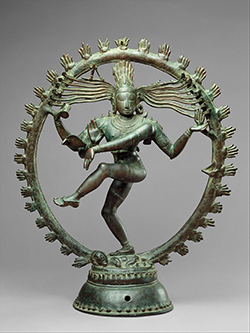
So here, each one of us, according to the Hindu idea, is the godhead, on purpose, getting lost, for the fun of it. And how terrible can it get at times ... but won’t it be nice when you wake up. That’s sort of the basic idea. And I have found it’s an idea that any child can understand. And it has great simplicity and great elegance.
05:58
Now, in part of this cosmology, we must understand another feature of this conception of the universe. Not only ah... Remember now, the ‘kalpers’, the periods of time; the ‘hugers’, the qualities of the time, through which the universe goes, but there is the final thing, which are called ‘the six worlds’, or the six paths of life.
And this is very important for Buddhism, although it comes from Hinduism, is represented in what is called the ‘bhava chakra’. ‘bhava’ means becoming, ‘b’, ‘h’, ‘a,’ ‘v,’ ‘a’. ‘chakra’, ‘c’, ‘h’, ‘a’, ‘k’, ‘’r, ‘a,’ means ‘wheel’. The wheel of becoming; the wheel of birth and death. And it has six divisions:
It has the top people, and the bottom people. The top people are called ‘deva’—‘d’, ‘e’, ‘v’, ‘a’. The bottom people are called ‘naraka’—‘n’, ‘a’, ‘r’, ‘a’, ‘k’, ‘a’. Devas are angels and they are the people who are the supreme spiritual successes. The Naraka are tormented in purgatory, and they are the supreme spiritual failures. They are the poles: the happiest people; and the saddest people.
Then in between , there comes the world of the ‘pretas’. Next to the Naraka—next to purgatory. The Pretas are the frustrated spirits, who have tiny mouths and enormous bellies. Huge appetites, but very, very limited means of satisfying them. They come between the Narakas and the Devas at the top.
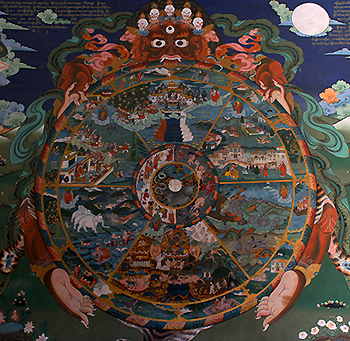
Next up from the Pretas are the human beings. And they are supposed to hold a middle position in the six worlds.
Then you go up from the human beings, from the Devas, and then you start coming down again. The next world is called the ‘Asura’. And those are the wrathful spirits—the personifications of storms and all the anger and violence of nature.
Next down is animals. Coming between the Asura and the Purgators again.
Now all these needn’t be taken literally. They are different modalities of the human mind. We are in the Naraka world when we are frustrated and in torment. When we are merely chronically frustrated, we are in the Preta world. When we are in a state of equanimity, even mindedness, we are in the Human world. When we are deliriously happy, we’re in the Deva world. When we are furious, we are in the Asura world. And when we are dumb, we are in the Animal world.
So these are all modalities. And it would be said now, this is terribly important to understand Buddhism. Because the better you get, the more you go up to the Deva world. The worse you get the more you go down to the Naraka world. But everything that goes up, has to come down. So you can’t improve yourself indefinitely: if you improve yourself beyond a certain limit, you simply start to get worse. Like when you make a knife too sharp, it begins to wear away.
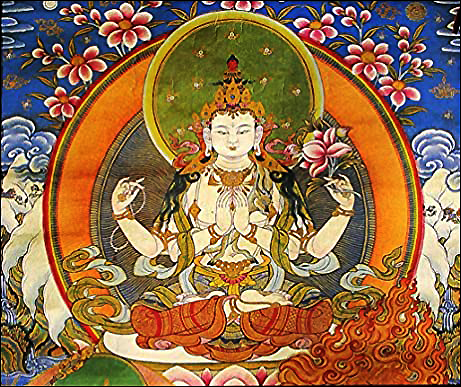
06:25
So the Buddhahood, or liberation, enlightenment, is on no place on the wheel—unless it might be the centre. By ascending, by becoming better, you tie yourself to the wheel by gold chains. By retrogressing and becoming worse, you tie yourself to the wheel with iron chains. But the Buddha is one who gets rid of the chains altogether. And so, this will explain why Buddhism, unlike Judaism and unlike Christianity, is not very, very frantically concerned with being good. It is concerned with being wise.
It is concerned with being compassionate—a little different from being good. With having tremendous sympathy and understanding and respect for all the ignorant people who don’t know that they’re it. But who are playing the very far out game of being you and I.
And so this is why every Hindu greets his brother, not by shaking hands, but by putting his hands together and bowing. This is why the Japanese bow to each other. Basically. This is why the Buddhist rituals are full of the bowing gesture. Because you are honouring the self, playing the roles of all the people around you. And all the more honour is due when the self has forgotten what it’s doing. And is therefore in a very far out situation.
08:09
Now, that is the basic Hindu view of the world. That’s the cosmology that goes along with Buddhism. According to taste, temperament, tradition, popular belief and so on, there is this additional idea that when the Lord, the self, pretends that it is each of us, it first of all pretends that it is something called the ‘divatman’—the ‘atman’, the self—pretends to be an individual soul called the ‘divatman’. And the Divatman reincarnates through a whole series of bodies: life after life, after life ... And ahrr... according to what is called ‘Karma’. ‘Karma’ literally means ‘doing’. The law of doing, whereby acts occur in a series and they are linked with each other, in an unbreakable chain. How everybody’s karma is the life course that he will work out through, maybe, innumerable lifetimes.
I’m not going into that because a lot of Buddhists don’t believe that. You will find that the Zen people for example, are quite divided on this. They will say: ‘No we don’t believe literally in reincarnation. That after your funeral, you know, you will suddenly become somebody different, living somewhere else.’ They will say: ‘Reincarnation means this: that if you, sitting here now, are really convinced that you are the same person that walked in at the door, half an hour ago, you’re being reincarnated. If you are liberated, you will understand that you are not. The past doesn’t exist. The future doesn’t exist. There is only the present. And that’s the only real you that there is.
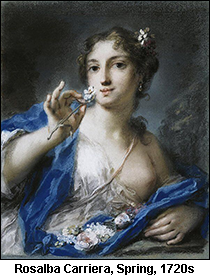
The Zen master Dogen put it in this way, he said: ‘Spring does not become the summer. First there is summer and then there is spring. Each season stays in its own place.’ And so, in the same way, the you of yesterday does not become the you of today.
T.S. Eloit has the same idea in his poem, ‘The Four Quartets’. Where he says: ‘When you settle down in the train to read your newspaper, and so on, you are not the same person who, a little while ago, left the platform.’
11:03
If you think you are, you are linking your moments up in a chain. And this is what binds you to the wheel of birth and death. But when you know that every moment, that which you are, is the only moment, this comes into Zen. A master will say to somebody: ‘Now get up and walk across the room.’ And he comes back and he says: ‘Where are your footprints?’ ‘They’ve gone.’ ‘So where are you? Who are you?’
When we ask who we are, we usually give a kind of recitation of a history: ‘Well I’m so-and-so. I was given this name by my parents. I’ve been to such-and-such a college. I’ve done these things in my profession—I produce a little biography. Buddha says: ‘Forget it. That’s not you. That’s some story. That’s all gone. That’s all past. I want to see the real you, who you are now.’ Nobody knows who that is you see. Because we don’t know ourselves except through listening to our echoes. And consulting our memories. But then there’s the real you, and that again leads us back to this question: ‘Who are you? That is the real you.’
We shall see how they play with this in Zen, by the Koans, to get you to come out of your shell, and find out who you really are.

Well now, whereas in India, this world view is tied up with the whole culture involving every circumstance of everyday life. Hinduism is not a religion in the same sense that say being an Episcopalian or even a Roman Catholic. Hinduism is not a religion, it is a culture. In this respect, it’s more like Judaism than Christianity. Because a person is still recognisable as a Jew even though they don’t go to synagogue. Because there’s certain cultural things that Jewish people who come of a line of Jewish parents, people who have been practising Jews, they still continue certain ways of doing things, certain mannerisms, certain attitudes, and so they are cultural Jews instead of religious Jews.
13:38
Now Hinduism is the same sort of thing. It is a religion culture. And so it involves living in India. Really ... to be a Hindu. Because of the differences of climate, the differences of art and crafts, technology, you can’t be a Hindu in the full sense in Japan or in the United States.
So what is Buddhism. Buddhism is Hinduism stripped for export. Now the Buddha, was a reformer, you might say. In the higher sense of a reformer: someone who wants to go to the original forms. Or to re-form it, for the needs of a certain time.
The word ‘Buddha’ is a title. It’s not a proper name. The same way as ‘Christ’ means ‘the anointed’—it’s not the surname of Jesus. So Buddha is not the surname of Gautama, it means ‘the one who is awakened’. From the root in Sanskrit, ‘budh’, ‘to know’. The man who woke up, who discovered who he really was.
14:59
Now the crucial point, wherein Buddhism differs from Hinduism, is it doesn’t say who you are. It has no idea. No Concept. And I emphasise the word ‘idea’ and ‘concept’; it has no idea and no concept of God. Because, Buddhism is not interested in concepts. It’s interested in direct experience, and direct experience only. So from the Buddhist standpoint, all concepts are wrong. Just in the same way that nothing is really what you say it is.
This ... is this a stool? [He turns the stool upside down.] It isn’t now, its a waste basket. [beats out a rhythm on the top of a stool] It’s now a drum. What is this thing? See? It is what it does, isn’t it? See! Ha, ha, ha, ha, ha. Anything you can use it for is what it is. So if you have a rigid idea that it’s a stool and you can only sit on it. You’re kind of stuck. But if you’ve got all these other things as well, then you suddenly see that anything can be everything.
16:58
So in the same way Buddhism does not define, and say, what you really are, is something. Because it would say that if you believe that, you’ve got stuck with an idea ... and you’re clinging onto it ... for spiritual security. So a lot of people say: ‘Well, I like to have a religion because it gives me something to hold on to. A Buddhist would say: ‘Ah, cut that stuff. So long as you hold onto something, you don’t have religion. You are only really there when you let go of everything. And you don’t depend on any fixed idea, any belief, for your sanity or happiness.
So you would think that Buddhism is very destructive. Because it breaks down ... it doesn’t believe in God ... it doesn’t believe in an immortal soul ... it doesn’t believe in, seek any solace in, any idea of life after death. It absolutely faces the fact of the transiency of life. There’s nothing you can hold onto. So man, let go. Because there’s no-one to hold onto anything anyway.
So Buddhism is the discipline of doing that. But if you do that, you see ... you’ll discover something much better than anybody has that has a belief. ’Cause you’ve got the real thing. Only you can’t say what it is.
They say in Zen, if you’re enlightened in Buddhism, you are like a dumb man who’s had a wonderful dream. That is to say, when you’ve had a wonderful dream you want to tell everybody what it is. But you can’t, ’cause you’re dumb. You can’t speak.
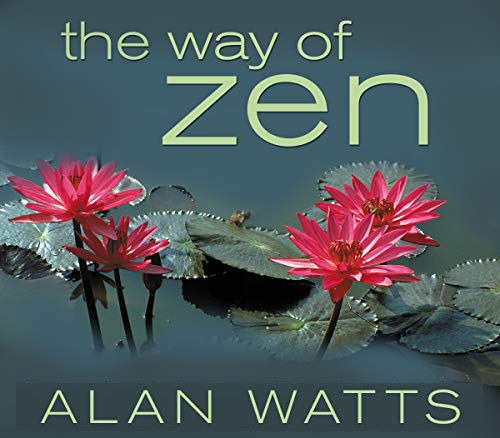
So there’s a real thing in Buddhism, which they call Nirvana, which is the subtle equivalent to ‘noxia’. ‘Nirvana’ means blow out. ‘Phhhew...’ You know, the sigh of relief. Because if you hold your breath, you lose it. If you hold on to yourself, if you hold on to life, or breath is the spirit, you hold onto God, ‘Rock of ages, cleft for me’ ... Let me cling on to you! It’s all dead ... becomes just a rock ... Just an idol. But let go. Breathe out. And you get your breath back. That’s Nirvana.
19:15
So the Buddhist idea is, in doctrine the highest negativism, so you’d characterise the ultimate reality as 'shunya’In Hindi zero is called 'shunya', meaning a void, the supreme state of awareness where everything comes to nothingness. ... It is said that everything returns to zero or nothingness before being created anew—newindianexpress.com, which means ‘emptiness’.
In Japanese ‘ku’, which is the character you use for the sky, or the air. When you get an air mail envelope, to write home, the second character is ‘ku’, the air, which means emptiness. And they use this to translate 'shunyata'In Buddhist philosophy, 'Sunyata' is the voidness that constitutes ultimate reality; sunyata is seen not as a negation of existence but rather as the undifferentiation out of which all apparent entities, distinctions, and dualities arise—britannica.com,, emptiness. The fundamental nature of reality. The sky. The sky, you see, is not negative emptiness. The sky contains all of us. It’s full of everything going on. But you can’t put a nail in the sky, and pin it down.
So, in the same way, Buddhism is saying, you don’t need any gizmos, to be in the know. You don’t need a religion. You don’t need any even Buddha statues. You don’t need any temples. You don’t need any Buddhist ‘bondieuserie’, rosaries and all that jazz. But when you get to the point that you know you don’t need any of those things. That you don’t need a religion at all. Then it’s fun to have one. Then as it were, you can be trusted to use rosaries and ring bells and ??cavers and chant sutras etc. But those things won’t help you a bit, they’ll tie you up in knots, if you use them as methods of catching hold of something.
So every teacher of Buddhism, is a debunker. But he does it, not to be a smart Alec and to show how clever he is, but out of compassion. Just as when a surgeon chops off a bad growth, or a dentist pulls out a rotten tooth. So, the Buddhist guru, or surgeon, is getting rid of your crazy ideas for you ... which you use to cling on to life and make it dead.
21:27
Now, there are two kinds of Buddhism: They are called Mahayana; ‘maha’ the Sanskrit word for great; ‘yana’ means a vehicle, or conveyance. And there is ‘Hinayana’—means ‘the little vehicle’. ‘Hina’ in Sanskrit means little—only that’s a term invented by the Mahayanas ... for the other people ... and the other people don’t like it. They like to call themselves ‘pheravada’ (‘p’, ‘h’, ‘e’, ‘r’, ‘a, ‘v’, ‘a’, ‘d’, ‘a’), which means ‘vada’, ‘the way’; ‘phera’ of the elders.
Now Pheravada Buddhism you will find in Ceylon, Burma, Thailand, Cambodia and generally South Asia. Mahayana, you’ll find’ in ... it originated in Nepal, Northern India, and you’ll find it in Tibet, China, Mongolia, Japan. And to some extent in Indonesia. The Mahayana, is, what we are finding here. All the sects of Japanese Buddhism are Mahayana.
Now what’s the great difference between these two schools?
The Pheravada is very strict. It’s the way for monks essentially, rather than the layman. And it is ah ... You see there are many ways of living Buddhism. It’ll take me some time to show you this.
The Pheravada Buddhists are trying to live without desire. To have no need, or wives, or girls, or husbands, or boyfriends. Not to kill anything at all. To live the strictest vegetarian way. And to strain your water, so that you even don’t eat any little insects with it. And to live this very strict way, and to meditate all the time. And eventually attain Nirvana, which will involve your total disappearance from the manifested world.
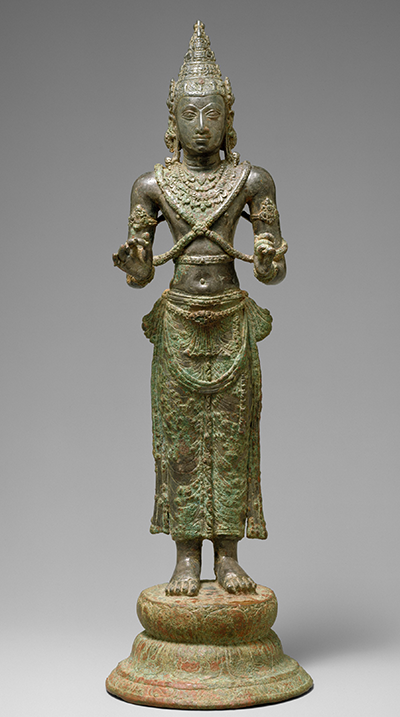
Mahayana feeling is that that is a dualistic point of view: you don’t need to get away from this world to experience Nirvana, because Nirvana is what there is, it’s here, it’s now. So the ideal person of Mahayana is called a bodhisattva(in Mahayana Buddhism) a person who is able to reach nirvana but delays doing so through compassion for suffering beings―Oxford Languages.
24:20
So the ideal person of Mahayana is called a bodhisattva. This originally meant, somebody on the way to becoming a Buddha. But in Mahayana it has a different meaning. It means somebody who has become a Buddha, but has gone back into the world. Out of ... in the spirit of compassion, to help all other beings to become awakened. Well now that’s an endless task: it’s like filling a well with snow, you know, put snow into a well, it never fills up.
So, when it’s a Zen monastery, they’ve said their homage to the Buddha, the dharmaAn important Hindu, Buddhist and yogic concept, referring to a law or principle which governs the universe. ... Dharma is considered to be one of the three jewels of Buddhism, alongside sangha and buddha, together paving the path to enlightenment—yogapedia.com, that’s say, the Buddha’s doctrinal method, and the sanghaThe Sangha is the Buddhist community; it is the men, women and children who follow the teachings of the Buddha. The term, which in Sanskrit and Pāli means ‘collection’ or ‘assemblage’, a group of people living together for a certain purpose, has come to have two different referents—oxford biographies.com, the order of followers of Buddha. Then they take five vows:
And one of them is, however innumerable sentient beings are, I vow to liberate them all.
Well so you will see, there’s no end to that ... never comes a time when all sentient beings are liberated. But actually from the standpoint of one who is a Buddha, he sees everybody as liberated. In other words, if I were to be a Buddha, I wouldn’t say: ‘Now look everybody, I’m a Buddha, and I’m more experienced than you, and I know more than you, and you owe me respect on that account.’
On the other hand, I would see you all as being exactly right where you are. All of you Buddhas. And ever those of you who don’t know it, it would be right for you not to know it at this moment.
26:12
In talking about Buddhism in past seminars, I explain that it’s absolutely fundamental to an understanding of Buddhism, to recognise that it’s whole method of teaching, is dialectic. That is to say, it consists of a dialogue between a teacher and a student. And the method of this dialogue is called ??upia [perhaps ‘upadi’], that is to say skilful means used by the teacher to bring about the enlightenment of the student. The word ‘upia’, meaning expert pedagogy in teaching, but meaning ‘deceit’ when used in a political context.
And since Buddhism is a dialogue, what you ordinarily understand as the teachings of Buddhism, are not the teachings of Buddhism, they are simply the opening gambit, or the opening process of this dialogue. And the point being ... that Buddhism is not a teaching, it’s essence consists in a certain kind of experience; in a transformation of consciousness which is called awakening or enlightenment. Which involves our seeing through or transcending the hoax of being a separate ego.
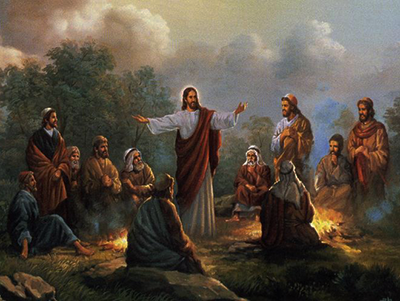
28:00
And so a Buddhist does not have the same tendency that a Christian has to want to find out what his faith is by going back to the most original sources. There has always been a tendency in Christianity, to ask: ‘What did Jesus really teach? What is the pure new testament? Uncorrupted by theologians, and by scribes who inserted things into the mouth of the master.’ It does not occur to Buddhists to have this attitude. Because of this dialectic pattern.
You see, when you have an acorn. If it’s a lively acorn, it grows into an oak. And that’s the way it should be. In other words, develop into something. And so, Buddhism as it has developed, since the days of the Buddha, has gone a long way ... It has become, sometimes more complex, sometimes more simple. But it has changed radically, because the seed which the Buddha planted, was alive.
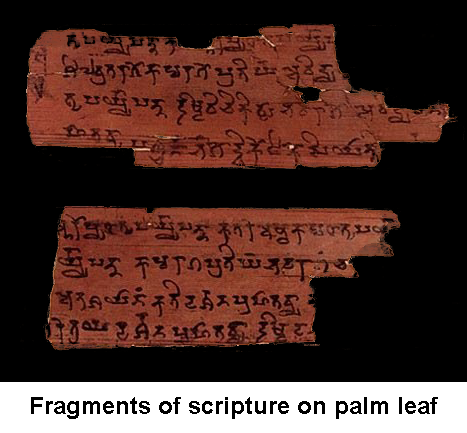
28:47
Now, for example, when we ask: ‘What are the Buddhist scriptures?’ You can get two answers to that question. In the Southern School, there is a set of scriptures which are written in the Parli language, divided into three sections, called the ‘Tripitaka'the Vinaya Pitaka, the Sutta Pitaka, and the Abhidhamma Pitaka.—study.com, which means the three baskets
. Because these palm-leaf manuscripts, on which these sutras were eventually written down, were of course carried around in baskets. And three baskets of these palm-leaf manuscript volumes comprise the Buddhist scriptures.
But you must remember, that in the evolution of these scriptures, that the Buddha wrote nothing, nor did his immediate disciples. That’s a very important thing to remember, that all Indian scriptures were for many centuries, handed down aurally. And so we have no clear guide as to their date. Because when you hand down an oral tradition, you are not always likely to preserve certain historical landmarks.
Supposing we are talking about a certain king. The name of this king will mark a historical point. But in an oral tradition, the name of the king is likely to be changed, every time the story is told, to correspond to the king then reigning.
So, in other words, things that do change, that have a historical rhythm, like the succession of kings, they will be changed in handing down the oral tradition. But things that do not change, that is to say, the essential principle of the doctrine, they won’t be altered at all.
31:43
So you must remember that the Buddhist scriptures, were for some hundreds of years, handed down orally, before they were ever committed to writing. And that accounts for their monotonous form. That is why everything is numbered; why there are Four Noble Truthsthe truth of suffering, the truth of the cause of suffering, the truth of the end of suffering, and the truth of the path that leads to the end of suffering—pbs.org; Eight Steps of the Eightfold Path
1. Right understanding (Samma ditthi);
2. Right thought (Samma sankappa);
3. Right speech (Samma vaca);
4. Right action (Samma kammanta);
5. Right livelihood (Samma ajiva);
6. Right effort (Samma vayama);
7. Right mindfulness (Samma sati);
8. Right concentration (Samma samadhi);
Ten FettersIn Buddhism, a mental fetter, chain or bond, shackles a sentient being to saṃsāra, the cycle of lives with dukkha.
1. belief in a self (Pali: sakkāya-diṭṭhi);
2. doubt or uncertainty, especially about the Buddha's awakeness and nine supermundane consciousnesses (vicikicchā);
3. attachment to rites and rituals(sīlabbata-parāmāsa);
4. sensual desire (kāmacchando);
5. ill will (vyāpādo or byāpādo);
6. lust for material existence, lust for material rebirth (rūparāgo);
7. lust for immaterial existence, lust for rebirth in a formless realm(arūparāgo);
8. conceit (māna)
9. restlessness (uddhacca);
10. ignorance (avijjā)—wikipedia;
Five SkandhasThe five aggregates or heaps of clinging are:
1. form (or material image, impression) (rupa);
2. sensations (or feelings, received from form) (vedana);
3. perceptions (samjna);
4. mental activity or formations (sankhara);
5. consciousness (vijnana)—wikipedia.org;
Four Brahma ViharasThe four divine states of dwelling are:
1. metta (loving kindness);
2. karuna (compassion);
3. mudita (sympathetic joy or empathy);
4. and upekkha (equanimity). or meditation states. And so on, and so on. Everything is put in numerical lists. So as to be memorised easily. Ad so there are formulae which are constantly repeated. And this is supposed to aid the memory.
Now then, it is obvious that those scriptures of the Parli canon, when you really sit down and read them, you know that, what has happened here, is that partly they have a certain monotony, due to mnemonic aids, but also that in the course of time, before they were written down, many monks spent wet afternoons, adding to them. And adding things in such a style that no inspired person could ever have said them. And they made commentaries upon commentaries upon commentaries. And lots of them had no sense of humour.
I always love the passage where the Buddha is giving instructions on the art of meditation. And he’s describing a number of things on which one could concentrate. And there’s a commentator making little notes on this, and so when he’s made his list of things on which you could concentrate, like a square drawn on the ground, or the tip of your nose, or a leaf, or a stone, or anything, and then he says: ‘or on anything’. And the commentator puts a footnote: ‘but not any wicked thing.’ I mean that’s professional clergy for you, the world over.
34:00
So, this sort of thing has obviously happened, but you must remember that this is not, this accumulation, this attribution of one’s own writings to the Buddha, is not done in a dishonest way. It would be dishonest today, with our standards, our literary historicity and correctness. 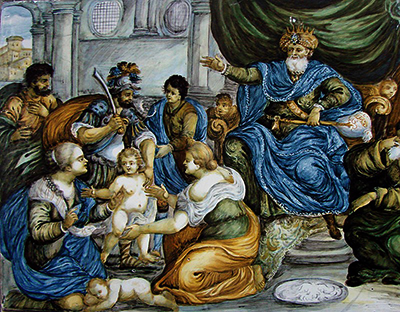 It would be very wrong of me to forge a document and pretend that it was written by some very venerable person say by Dr Suzuki or by Goethe. Huh! But centuries ago, both in the West and in the East, it was considered quite immoral to publish any book of wisdom under your own name. Because you, personally, were not entitled to the possession of this knowledge. And that is why you always put, on any book of wisdom, the name of the real author, that is to say the person who inspired you. So in this way, it is highly doubtful, if ‘The Book of the Wisdom of Solomon’, at least it’s not only doubtful but it’s perfectly certain, that Solomon never wrote it. But that it was attributed to Solomon because Solomon was an archetype of the wise man.
It would be very wrong of me to forge a document and pretend that it was written by some very venerable person say by Dr Suzuki or by Goethe. Huh! But centuries ago, both in the West and in the East, it was considered quite immoral to publish any book of wisdom under your own name. Because you, personally, were not entitled to the possession of this knowledge. And that is why you always put, on any book of wisdom, the name of the real author, that is to say the person who inspired you. So in this way, it is highly doubtful, if ‘The Book of the Wisdom of Solomon’, at least it’s not only doubtful but it’s perfectly certain, that Solomon never wrote it. But that it was attributed to Solomon because Solomon was an archetype of the wise man.
So in the same way, when for centuries, various Buddhist monks and scholars wrote all kinds of sutras, scriptures, and ascribed them to the Buddha, they were being properly modest. They were saying: ‘These doctrines are not my doctrines. They are the doctrines of, that proceed from, the Buddha in me. And therefore, they should be ascribed to Buddha.’
And so, over and above the Parli canon, there is an enormous corpus of scriptures, written originally in Sanskrit, and subsequently translated into Chinese and Tibetan. We have very inadequate manuscripts of the original Sanskrit. But we have very complete Chinese and Tibetan translations. So it is primarily, from Chinese and Tibetan sources, that we have the Mahayana canon of the scriptures, over and above the Pheravada canon, which is written in the Parli language.
36:51
Parli is a softened form of Sanskrit. Whereas in Sanskrit one says ‘nirvana’, in Parli one says ‘nivana’; Sanskrit says ‘karma’, Parli says ‘kama’; Sanskrit says ‘dharma’, Parli says ‘darma’. It’s a very similar language but its softer in its speech, articulation.
Now its a general feeling amongst scholars, of the West, that the Parli scriptures are closer to the authentic teachings of the Buddha than the Sanskrit ones. And so, with our Christian background, and approach to scriptures in general, the West has built up a very strong, you might say prejudice, in favour of the authenticity of the Pheravada tradition as against the Mahayana tradition.
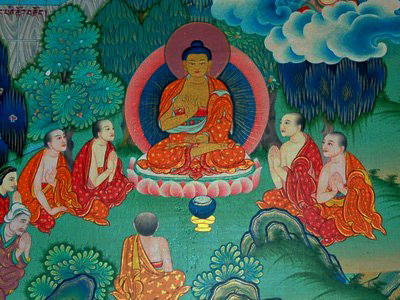
Whereas the Mahayanists put it this way. They have a hierarchy of scriptures. One for very simple minded people ... the next—they have about four grades—going progressively to the scriptures for the most intelligent people. And they say that the Buddha preached that to his intimate disciples first.
And then slowly, as he reached out from the most intimate group, to others, he came down to what is now the Parli canon, as the scriptures for the biggest dunderheads. But that the ones he preached first, were not revealed until long, long after his death. So they have no difficulty in making a consistent story about the fact that the scriptures in Sanskrit represent a level of the historic evolution of Buddhist ideas, that from our point of view, could not possibly have been attained in the Buddha’s lifetime. But you see that they say that the latest reveal is actually the first taught to the in-group.
39:36
Well, you’ve got to make allowances for these differences in points of view, and not entirely project Western standards of historical and documentary criticism onto Buddhist scriptures. Because, as I said, it is in the essence of Buddhism to be a developing process, because it is a dialogue.
So then, you can see the initial steps of the dialogue in our earliest, or presumed earliest records of Buddhism, in the Four Noble Truths, where you have it put out that the problem which Buddhism faces is suffering. This word ‘dukkha’, which we translate ‘suffering’, is the opposite of ‘sukkha’. ??‘Sukkha’ means what is sweet and delightful. ‘Dukkha’ means the opposite, what is bitter and frustrating. And Mahayanists will explain that the Buddha always taught by a dialectical method. That is to say, when people were trying to make the goal of life, the pursuit of sukkha, that is to say the pursuit of happiness, he counteracted this wrong view by teaching that life is essentially miserable.
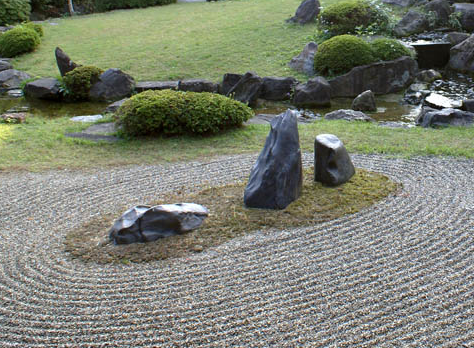
When people thought, for example, that there is a permanent and eternal self in each one of us, and clung to that, self, the Buddha, in order to counteract this one-sided view, taught the other extreme doctrine, that there is no fixed self in us—no ego. But a Mahayanist would always say: ‘The truth is the middle way: Neither sukkha nor dukkha. Neither atman nor anatmanPali: 'non-self' or 'substanceless'; Sanskrit 'anatman': the doctrine that in humans there is no permanent, underlying substance that can be called the soul. ... The concept of anatta, or anatman, is a departure from the Hindu belief in atman, 'the self'—britannica.com, 'Self nor non-self.’ The whole point is like this: Once when R. H. Blith was asked by some students: ‘Do you believe in God?’ He answered: ‘If you do, I don’t. If you don’t, I do.’ And so in much the same way, all Buddhist pedagogics, teaching, is specifically addressed, not to people in general, but to the individual who brings a problem. And wherever he seems to be over-emphasising things in one way, the teacher over-emphasises in the opposite way. So as to arrive at the middle way.
42:30
So then, with this emphasis on life as suffering, it’s simply saying: ‘This is the problem we’re dealing with. We hurt. We human beings, feel pretty unfairly treated. Because we are born into a world, so arranged, that the price that we pay for enjoying it, that is to say for having sensitive bodies, is that these bodies are at the same time, because they are sensitive, capable of the most excruciating agonies.’
Isn’t that a nasty trick to play on us. What are we going to do about it. This is the problem. So then the Buddha says: ‘The cause of suffering is desire.’ ‘Trishna’ is our word first, and may perhaps be translated ‘desire’ in a very general sense, or perhaps better ‘craving’, ‘clinging’, ‘grasping’. Something like that. He is saying: ‘Now, I am going to make this suggestion: you suffer because you desire. Now supposing then, you try not to desire, and see if by not desiring, you can cease from suffering.’
Or you can put the same thing in another way. You can say to a person: ‘It’s all in your mind. There is nothing either good or ill, but thinking makes it so.’ And therefore if you can control your mind, you’ve nothing else that you need control. For example, you don’t need to control the rain if you can control your mind. If you get wet, it’s only your mind that makes you think it’s uncomfortable to be wet. A person who’s got good mental discipline can be perfectly happy wandering round in the rain. You don’t need a fire if you’ve got good mind control. Because if you’ve got ordinary bad mind control, when it gets cold, you start shivering. That’s because you are putting up a resistance to the cold. You’re fighting it. But don’t fight it. Relax into the cold. And in other words, this is a matter of mental attitude. And then you’ll be fine.
Always control your mind. This is another way of approaching it you see.
45:20
Now then. As soon as the student begins to experiment with these things, he finds out that it’s not so easy as it sounds. Not only is it very difficult not to desire, not only is it very difficult to control your mind, but there’s something phoney about the whole business. And this is what you’re intended to discover. That namely, when you try and eliminate desire, in order to escape from suffering, you desire to escape from suffering. You are desiring not to desire. In other words, I’m not then merely playing with logic, I’m saying that a person who is escaping from reality will always feel the terror of it. It’ll be like the hound of heaven that pursues him. And he’s escaping in a way, even when he’s trying not to escape.

And it was this point you see, that this method of teaching, was supposed to educate from him, to draw out from him, not by saying to anybody all this in the first place. But by making the experiment not to desire, or the experiment to control your mind thoroughly ... this is the first step. To understand this you must go through that, or some equivalent of it. So as to come to the point as to see you’re involved in a vicious circle. That in trying to control your mind, you’re motivation, the reason for which you are doing it, is still clinging and grasping. It’s still self-protection. It’s still lack of trust ... and love.
47:35
So, when this is understood, the student returns to the teacher and says: ‘Look, this is my difficulty. I cannot eliminate desire because that itself, my effort to do so, is itself desire, I cannot eliminate selfishness because my reasons for wanting to be unselfish are selfish. As one of the Chinese Buddhist classics puts it: ‘When the wrong man uses the right means, the right means work in the wrong way.’ Now the right means are always traditional disciplines, and you’re going to use them you see, you’re going to practice zazan or whatever, and make yourself into a Buddha. But you see, if you are not a Buddha in the first place, you can’t become one, because you’ll be the wrong man. You are using the right means, but because you are using them for a selfish intent, or a fearful intent—you’re afraid of suffering and you don’t like it and you want to get out of it. You want to escape. All these you see, are the motivations which frustrate the right means. So one is meant to find that out.
And so then, in course of time, when all this is thoroughly explored, by the Buddhist disciples, there developed a very evolved form of this whole technique of dialectic. Which was called ‘madhyamika’. ‘m’,’a’, ‘d’, ‘h’, ‘y’, ‘a’, ‘m’, ‘i’, ‘k’, ‘a’. It means the middle way. But it was a form of Buddhist practice and instruction, developed by Nagarjuna, who lived approximately in 200 A.D.
49:30
Nagarjuna’s method, is simply an extension and drawing to logical conclusions of the method of dialogue that already existed. Except that Nagarjuna took it to an extreme. And his method is simply this:
To undermine, to cast doubts on, any proposition, to which his student will cling. to destroy all intellectual formulations and all concepts of the nature of reality and the nature of the self whatsoever.
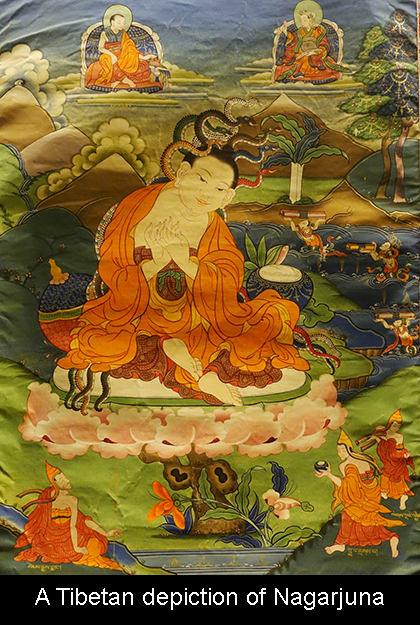
Now you might think that that was simply a parlour game, a little intellectual exercise, but if you engaged in it, you would find it was absolutely terrifying. And you would feel yourself brought very close to the verge of madness. Because a skilful teacher in this method reduces you to a shuddering state of total insecurity.
I have watched this being done among people you would consider perfectly ordinary, normal Westerners, who thought they were getting involved in just a nice, abstract, intellectual discussion. But then finally, the teacher, as the process goes on, discovers, in the course of the discussion, what are the fundamental premises to which every one of his students is clinging. What is the foundation of sanity. What do you base your life on. When he has found out what that is for each student, he destroys it. He shows you that you can’t found a way of life on that. That it leads you into all sorts of inconsistencies and foolishness.
51:39
And the student turns back to the teacher and says: ‘Well it’s all very well for you to pull out all the carpets from under my feet. What would you propose instead.’
And the teacher says: ‘I don’t propose anything.’ He’s no fool. He doesn’t put up something to be knocked down.
But you see, here are you. If you don’t put up something to be knocked down, then you can’t play ball with the teacher. Ha, ha, ha, ha., ha, ...And you might say: ‘Well, I don’t need to.’ Then on the other hand there’s something nagging you on the inside telling you to do. So you go and play ball with him, and he keeps knocking it down. Whatever you propose, whatever you cling to.
And this exercise, produces in the individual, a real traumatic state. People get acute anxiety. And you wouldn’t think so, because it just seems as if it were nothing more than a discussion on a very intellectual and abstract level. But when it really gets down to it and you find that you don’t have a single concept that you can really trust, it gives you the heebie jeebies. But you are preserved from insanity, by the discipline, by the atmosphere, set up by the teacher. And by the fact that he seems perfectly happy without anything by way of a concept to cling on to.
53:21
And the student looks at him and says: ‘He seems to be all right. Maybe I can be all right too.’ You know, it gives a certain confidence that the feeling that all is not mad because the teacher in his own way is perfectly normal.
* * * * * * *